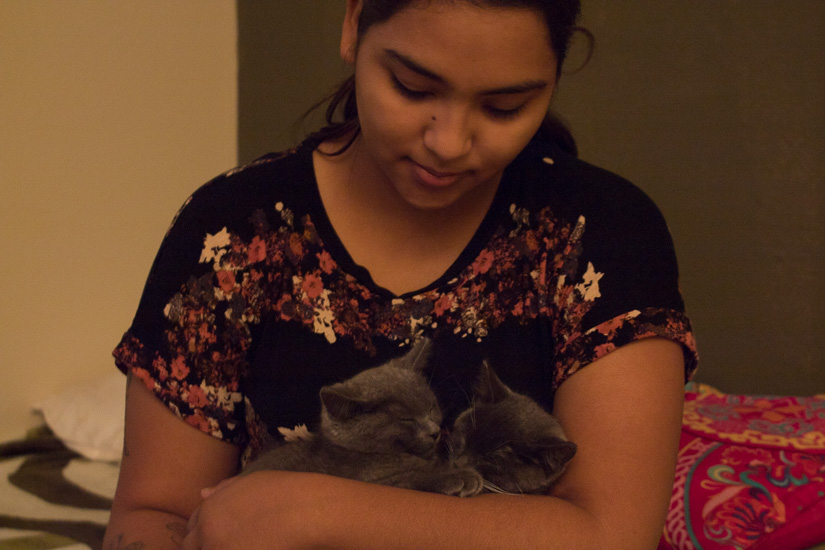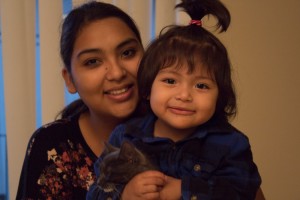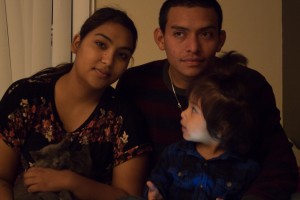Jaritza Hernandez became homeless at 18, when her husband lost his job and the rent for their apartment rose. They couldn’t keep up with the bills, especially when they needed to pay for all the costs associated with their new baby, Alexa, who has epilepsy. With no support from their families, the family of three ended up living in the back of their car for six months before they could find stable housing.
Hernandez wasn’t prepared to become homeless.
“I’m only 20 years old. I wasn’t trained for this. I wasn’t prepared for this life. No one told me that you could be homeless. No one told me how hard it was to pay bills, how hard it was to be a mother,” said Hernandez.

Homelessness tested Hernandez’s limits. She describes homelessness as the hardest battle of her life.
“It feels like when you lose a loved one. That’s exactly how it feels when you’re homeless. It’s like you’re losing yourself, you’re losing control of time, control of your inner self, control of everything,” she recalled of her experience a year ago.
Hernanadez’s experience represents a broader trend across the United States. According to a new report by the non-profit National Network for Youth, the number of homeless youth in the United States is much larger than it was thought to be. The report estimates there are 4.2 million homeless people under the age of 25 in the nation, whereas a 2016 government survey estimated there were only 170,820 homeless youth in the United States.
“It’s a huge epidemic,” said Tami Moore, the street outreach program coordinator from the Bill Wilson Center, a homeless youth shelter, in San Jose.
Youth homelessness is a particularly pressing issue in the Bay Area. According to a 2016 count, San Francisco and Santa Clara counties have two of the largest homeless youth populations in the United States, with 1,488 and 885 homeless youth respectively. County reports estimate that the numbers are much higher and that Santa Clara County has at least 2,530 homeless youth.
The median rents in the two counties are also two of the highest in California and in the nation. In San Francisco, the median rent is $1,784 and in Santa Clara County it is $2,065, which makes it very hard for people in minimum wage jobs to keep up with housing costs.
Despite the number of homeless youth in the Bay Area, youth homelessness often goes unseen and unsolved. Sometimes homeless youth don’t want to share their plight. Sometimes they don’t know who to ask for help and often there isn’t enough help available.

Youth tend to hide that they are homeless from their peers, teachers, coworkers and friends, which makes it hard for them to seek help and hard for service providers, like shelters, to find them. Hernandez, for example, was ashamed to be homeless so she couldn’t bring herself to call for help.
“I was embarrassed to say that I was homeless and with a kid,” said Hernandez. As a mother, Hernandez was also afraid that if she revealed she was homeless her daughter would be taken away, despite her best efforts to give Alexa all she needed.
In the end, Hernandez called the 211 number, a helpline that provides information and referrals to resources such as food, clothing and shelters, mental health and health services. Hernandez was referred to the Redwood City LifeMoves shelter, which housed her and then helped her find an apartment.

But many homeless youth don’t know the services available to them, said Cindy Burns, the McKinney Vento homeless youth assistance program coordinator at San Jose Unified School District.
Michele Huntzinger, the executive director of the Stand Up for Kids Silicon Valley outreach center in San Jose, thinks that holding a fair of all the services available to homeless youth would be a good way to ensure homeless youth know who they can turn to in times of need.
That doesn’t guarantee help would be available, though. Youth shelters are underfunded and overburdened, which means that they can only help a limited number of youth at a time.
“We don’t have enough shelters,” said Moore. At the LifeMoves shelter in Redwood City, the 700 beds are full every night, said CEO Bruce Ives.

More youth shelters are necessary because homeless youth don’t want to go to adult shelters where they fear mistreatment from homeless adults and where they cannot have their specific needs addressed. At youth shelters, homeless youth get to be with people their own age and can receive counseling that is specific to their needs.
Not enough spaces at youth shelters to accommodate the demand means that homeless youth and their families can often not get off the streets. “For a mom that slept in her car with her four kids, it took us two months to get her in the shelter,” said Moore of one of her clients.
Ives met another young mother that gave birth in a tent encampment – and was living there with her newborn – who couldn’t receive help because all shelters were full. All the shelters could do to help her was give her a voucher for a couple of days in a motel, and then hope that a space would become available for her and her baby.

Aside from overburdened shelters, there are other problems. According to Ives, the foster care system is a pipeline for homelessness. “A lot of kids in the foster care system get good support until age 18,” he said. After kids turn 18, they lose that support and end up homeless.
There’s no integrated support system across age groups or shelters. For youth that turn 25 and age out of youth shelters, they have to find aid elsewhere, said Huntzinger. Youth cannot smoothly transition into adult shelters, which means that at 25 they end up on the streets again with the prospect of long wait times to get into new shelters.
Despite all the ways in which youth can become or remain homeless, Ives believes there is hope. “It’s not a problem that is so overwhelming that it can’t be fixed,” he said.
